Islamic civilizations - Study guides, Class notes & Summaries
Looking for the best study guides, study notes and summaries about Islamic civilizations? On this page you'll find 100 study documents about Islamic civilizations.
Page 3 out of 100 results
Sort by
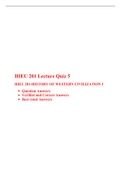
-
HIEU 201 Lecturer Quiz 5 Answer (3 Versions) / HIEU201 Lecturer Quiz 5 (Latest), HIEU 201-HISTORY OF WESTERN CIVILIZATION I, Liberty university.
- Exam (elaborations) • 9 pages • 2023
- Available in package deal
-
- $15.49
- + learn more
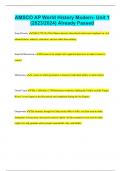
-
AMSCO AP World History Modern- Unit 1 (2023/2024) Already Passed
- Exam (elaborations) • 15 pages • 2023
- Available in package deal
-
- $9.99
- + learn more
AMSCO AP World History Modern- Unit 1 (2023/2024) Already Passed Song Dynasty (960-1279 CE) The Chinese dynasty that placed much more emphasis on civil administration, industry, education, and arts other than military. Imperial Bureaucracy Division of an empire into organized provinces to make it easier to control Meritocracy a system in which promotion is based on individual ability or achievement Grand Canal The 1,100-mile (1,700-kilometer) waterway linking the Yellow and the Yangzi Rivers....
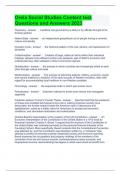
-
Orela Social Studies Content test Questions and Answers 2023
- Exam (elaborations) • 13 pages • 2023
- Available in package deal
-
- $23.49
- + learn more
Orela Social Studies Content test Questions and Answers 2023 Theocracy a political unit governed by a deity (or by officials thought to be divinely guided) Nation-State an independent geopolitical unit of people having a common culture and identity Dynastic Cycle the historical pattern of the rise, decline, and replacement of dynasties Collectivization Creation of large, state-run farms rather than individual holdings; allowed more efficient control over peasants; part ...
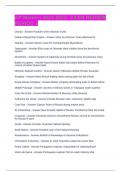
-
AP Modern 2024-2025: EXAM REVIEW PERIOD 2 QUESTIONS AND ANSWERS
- Exam (elaborations) • 5 pages • 2024
-
- $12.49
- + learn more
AP Modern : EXAM REVIEW PERIOD 2 Osman - Answer-Founder of the Ottoman Turks Defeat of Byzantine Empire - Answer-1453; by Ottoman Turks (Mehmed II) Istanbul - Answer-Islamic name for Constantinople (Byzantium) Janissaries - Answer-Elite corps of Ottoman slave soldiers from the devshirme system Devshirme - Answer-System of capturing young Christian boys for janissary corps Battle of Lepanto - Answer-Naval victory-Italian city-states defeat Ottomans for control of Indian Ocean tr...
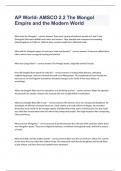
-
AP World- AMSCO 2.2 The Mongol Empire and the Modern World verified to pass 2023/2024
- Exam (elaborations) • 5 pages • 2023
- Available in package deal
-
- $11.49
- + learn more
AP World- AMSCO 2.2 The Mongol Empire and the Modern WorldWho were the Mongols? - correct answers They were a group of pastoral nomads in E and C Asia (Mongolia) that were skilled horse riders and archers. They attacked and conquered surrounding tribes/kingdoms in 1200s to 1300s bc they coveted wealth from Silk Road trade. What did the Mongols expect of everyone (male and female)? - correct answers To become skilled horse riders and to have courage in hunting and warfare. Who was Gengis Kh...
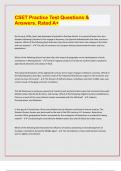
-
CSET Practice Test Questions & Answers. Rated A+
- Exam (elaborations) • 3 pages • 2023
- Available in package deal
-
- $8.49
- + learn more
CSET Practice Test Questions & Answers. Rated A+ By the early 1500s, Spain had developed a foothold in the New World. In a period of fewer than four decades following Columbus's first voyage of discovery, the Spanish defeated both the Aztec and Incas empires. Which of the following best illustrates the primary factor that led to the collapse of the Aztec and Inca empires? - -The lack of resistance to European disease disseminted the Aztec and Inca populations Which of the following fact...

-
Test Bank For International Business Competing in the Global Marketplace 11th Edition By Hill
- Exam (elaborations) • 1515 pages • 2023
-
- $31.99
- + learn more
Chapter 03 National Differences in Economic Development True / False Questions 1. GNI allows a more direct comparison of living standards in different countries. True False 2. In Sen's view, development is an economic process that should be assessed by material output measures such as GNI per capita. True False 3. Life expectancy at birth is one of the measures used by the Human Development Index (HDI) to measure the quality of human life in different nations....
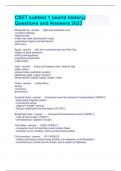
-
CSET subtest 1 (world history) Questions and Answers 2023
- Exam (elaborations) • 10 pages • 2023
- Available in package deal
-
- $19.49
- + learn more
CSET subtest 1 (world history) Questions and Answers 2023 Mesopotamia tigris and euphrates river cuneiform (writing) organized gov. written law code (hammurabi's code) systemized religion (zoroastrianism) astronomy Egypt Nile river, mediterranean and Red Sea religion of gods (pharaoh) writing (hieroglyphics) engineering (pyramids) mathematics India Indus and Ganges rivers, Arabian Sea urban culture planned cities (sanitation system) Metallurgy (gold, copper, bronze...
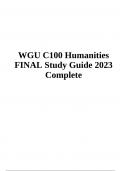
-
WGU C100 Final Exam Questions With Answers Latest Update 2023/2024 | GRADED
- Exam (elaborations) • 28 pages • 2023
- Available in package deal
-
- $18.49
- + learn more
Romantic Period Acronym (INNER HP- Inner romantic hero & passion) Correct Answer: INNERIndividiualism, Nationalism, Nature, Exoticism, Revolution HP- Heroism, Passion Realism Period Acronym (I ID AoD - I Identify Age of Doubt) Correct Answer: I- Industrialization ID- Individualism, Darwinism AoD- Age of Doubt Classical Period Correct Answer: artists and philosophers were concerned with harmony and balance* in their works Classical Philosophers Correct Answer: Socrates, Plato, and Aristotl...
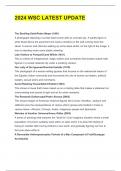
-
2024 WSC LATEST UPDATE
- Exam (elaborations) • 26 pages • 2024
- Available in package deal
-
- $8.69
- + learn more
2024 WSC LATEST UPDATE The Strolling Saint/Pedro Meyer (1991) A photograph depicting a surreal street scene with an overcast sky. A saintly figure in white floats above the pavement and casts a shadow on the wall running down the street. A woman and child are walking up some steps whilst, on the right of the image, a man is standing under some plastic sheeting. Late Visitors to Pompeii/Carel Wilink (1931) This is a blend of metaphysical, magic realism and surrealism that situates suited ...

How did he do that? By selling his study resources on Stuvia. Try it yourself! Discover all about earning on Stuvia


